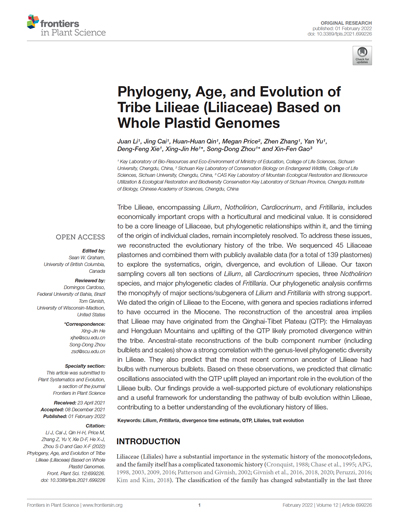NEWS 2022
Phylogeny, Age, and Evolution of Tribe Lilieae (Liliaceae) Based on Whole Plastid Genomes
Juan LI1, Jing CAI1, Huan-Huan QIN1, Megan PRICE2, Zhen ZHANG1, Yan YU1, Deng-Feng XIE1, Xing-Jin HE1, Song-Dong ZHOU1, Xin-Fen GAO3
Frontiers in Plant Science (2022)
https://doi.org/10.3389/fpls.2021.699226
Department of Plant Physiology, Institute for Biological Research “Siniša Stanković“—National Institute of the Republic of Serbia, University of Belgrade, 1Key Laboratory of Bio-Resources and Eco-Environment of Ministry of Education, College of Life Sciences, Sichuan University, Chengdu, China
2Sichuan Key Laboratory of Conservation Biology on Endangered Wildlife, College of Life Sciences, Sichuan University, Chengdu, China
3CAS Key Laboratory of Mountain Ecological Restoration and Bioresource Utilization & Ecological Restoration and Biodiversity Conservation Key Laboratory of Sichuan Province, Chengdu Institute of Biology, Chinese Academy of Sciences, Chengdu, China
Abstract
Tribe Lilieae, encompassing Lilium, Notholirion, Cardiocrinum, and Fritillaria, includes economically important crops with a horticultural and medicinal value. It is considered to be a core lineage of Liliaceae, but phylogenetic relationships within it, and the timing of the origin of individual clades, remain incompletely resolved. To address these issues, we reconstructed the evolutionary history of the tribe. We sequenced 45 Liliaceae plastomes and combined them with publicly available data (for a total of 139 plastomes) to explore the systematics, origin, divergence, and evolution of Lilieae. Our taxon sampling covers all ten sections of Lilium, all Cardiocrinum species, three Notholirion species, and major phylogenetic clades of Fritillaria. Our phylogenetic analysis confirms the monophyly of major sections/subgenera of Lilium and Fritillaria with strong support. We dated the origin of Lilieae to the Eocene, with genera and species radiations inferred to have occurred in the Miocene. The reconstruction of the ancestral area implies that Lilieae may have originated from the Qinghai-Tibet Plateau (QTP): the Himalayas and Hengduan Mountains and uplifting of the QTP likely promoted divergence within the tribe. Ancestral-state reconstructions of the bulb component number (including bulblets and scales) show a strong correlation with the genus-level phylogenetic diversity in Lilieae. They also predict that the most recent common ancestor of Lilieae had bulbs with numerous bulblets. Based on these observations, we predicted that climatic oscillations associated with the QTP uplift played an important role in the evolution of the Lilieae bulb. Our findings provide a well-supported picture of evolutionary relationships and a useful framework for understanding the pathway of bulb evolution within Lilieae, contributing to a better understanding of the evolutionary history of lilies.




